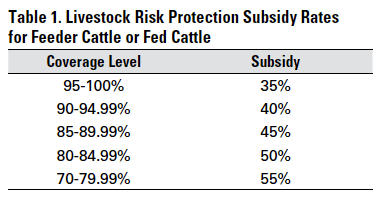Key Elements to Think About When Deciding On Livestock Danger Security (LRP) Insurance Coverage
When examining alternatives for Livestock Threat Protection (LRP) insurance policy, several crucial factors call for mindful consideration to make certain effective danger monitoring in the agricultural field. Selecting the ideal coverage choices customized to your specific livestock operation is extremely important, as is understanding exactly how premium prices correlate with the level of security supplied.
Coverage Options
When thinking about Livestock Risk Protection (LRP) insurance policy, it is essential to recognize the numerous insurance coverage choices offered to reduce risks in the farming field. Animals Danger Protection (LRP) insurance provides different insurance coverage choices tailored to meet the varied requirements of livestock manufacturers.
An additional important protection option is the endorsement duration, which identifies the length of time the insurance coverage is in impact. Producers can choose the endorsement period that best fits their production cycle and market conditions. In addition, insurance coverage degrees and prices differ based upon the sort of animals being insured, providing producers the versatility to personalize their insurance coverage plans according to their details demands.
Understanding the various coverage choices available under Animals Risk Security (LRP) insurance policy is critical for producers to make enlightened decisions that successfully protect their animals procedures from market uncertainties.
Costs Costs

Animals Danger Protection (LRP) insurance gives necessary protection choices tailored to minimize threats in the agricultural sector, with a substantial facet to think about being the calculation and framework of premium expenses. These include the kind and number of livestock being guaranteed, the protection level picked, the present market prices, historic cost information, and the size of the coverage duration.
Insurance providers examine historic information on livestock costs and manufacturing prices to determine a suitable premium that mirrors the degree of threat involved. It is vital for animals manufacturers to meticulously evaluate premium costs and protection choices to guarantee they are appropriately protected versus prospective monetary losses due to damaging market problems or unpredicted occasions.
Qualified Animals
The resolution of qualified livestock for Animals Danger Security (LRP) insurance protection includes careful factor to consider of certain requirements and characteristics. Animals kinds that are usually eligible for LRP insurance policy include feeder cattle, fed swine, livestock, and lambs.
Feeder cattle, for instance, are commonly qualified for LRP insurance coverage if they fall within defined weight ranges. Lambs are one more group of livestock that can be thought about for LRP insurance policy, with elements such as weight and age playing a vital role in identifying their qualification.
Before selecting LRP insurance coverage for animals, manufacturers ought to very carefully assess the eligibility requirements detailed by the insurance policy service provider to ensure their animals fulfill the essential requirements for coverage.
Policy Versatility
Plan adaptability in Animals Threat Protection (LRP) insurance enables producers to tailor protection to fit their certain demands and risk monitoring approaches. This adaptability encourages animals manufacturers to tailor their insurance plans based upon variables such as the sort of livestock they possess, market problems, and specific threat resistance levels. One essential aspect of policy flexibility in LRP insurance is the ability to pick insurance coverage degrees that line up with the browse around here producer's monetary goals and risk direct exposure. Manufacturers can choose protection levels that shield them versus here are the findings prospective losses because of fluctuations in livestock rates, guaranteeing they are effectively insured without overpaying for unneeded protection. Furthermore, LRP insurance supplies adaptability in policy duration, permitting producers to select insurance coverage durations that best fit their manufacturing cycles and advertising and marketing timelines. By providing customizable alternatives, LRP insurance coverage enables manufacturers to effectively handle their danger exposure while guarding their livestock procedures against unforeseen market volatility.
Cases Process
Upon experiencing a loss or damage, manufacturers can launch the claims process for their Animals Threat Defense (LRP) insurance by immediately calling their insurance policy supplier. It is crucial for producers to report the loss immediately to accelerate the cases procedure. When connecting to the insurance company, producers will certainly require to supply thorough details about the incident, including the date, nature of the loss, and any relevant documentation such as veterinary records or market value.

After the assessment is total, the insurance policy company will certainly choose pertaining to look at more info the claim and interact the end result to the producer. The producer will obtain compensation according to the terms of their Livestock Danger Defense (LRP) insurance policy if the insurance claim is accepted. It is essential for producers to be acquainted with the cases process to guarantee a smooth experience in the occasion of a loss

Final Thought
To conclude, when selecting Livestock Risk Defense (LRP) insurance policy, it is vital to consider insurance coverage alternatives, premium expenses, eligible livestock, plan adaptability, and the cases process. These essential elements will aid make sure that farmers and breeders are properly protected versus prospective dangers and losses associated with their animals procedures. Making a notified decision based upon these considerations can ultimately bring about much better financial security and assurance for livestock manufacturers.
Animals Risk Defense (LRP) insurance coverage offers various protection options customized to satisfy the varied requirements of livestock producers.The determination of qualified animals for Livestock Danger Security (LRP) insurance coverage involves cautious consideration of particular requirements and qualities.Plan adaptability in Livestock Threat Protection (LRP) insurance policy enables manufacturers to tailor insurance coverage to suit their certain needs and run the risk of management methods.Upon experiencing a loss or damages, producers can start the cases process for their Animals Threat Protection (LRP) insurance policy by promptly contacting their insurance policy service provider.In verdict, when selecting Livestock Danger Defense (LRP) insurance, it is vital to take into consideration coverage choices, premium expenses, qualified animals, policy versatility, and the insurance claims procedure.